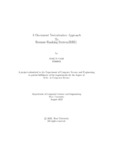| dc.contributor.advisor | Hossain, Dr. Muhammad Iqbal | |
| dc.contributor.author | Nabi, Norun | |
| dc.date.accessioned | 2023-03-14T10:22:55Z | |
| dc.date.available | 2023-03-14T10:22:55Z | |
| dc.date.copyright | 2022 | |
| dc.date.issued | 2022-08 | |
| dc.identifier.other | ID: 19366001 | |
| dc.identifier.uri | http://hdl.handle.net/10361/17980 | |
| dc.description | This thesis is submitted in partial fulfillment of the requirements for the degree of Master of Science in Computer Science and Engineering, 2022. | en_US |
| dc.description | Cataloged from PDF version of thesis. | |
| dc.description | Includes bibliographical references (page 24). | |
| dc.description.abstract | Technology transformed the way how job seekers apply for a job and recruiter’s hunting
for a precise pick . Now, paper version of resume already become an outdated version of
job application method. Electronic resume replaces the old method thanks to its easier
access to technology. When it comes to a particular job requirement, screening a rele vant resume among thousands is an exhaustive and time consuming recruitment process
because the respective HR of an organization must have a proof read the entire resume
set to select the right person in the right position, a key decision for any organization.
Extracting the semantic meaning from resume is otherwise a daunting task. By making
the selection process fast and accurate, organizations could save huge efforts and money.
Using state-of-art-technology could be a way out. In the field of NLP, there are a range
of tools to classify documents. Document vectorization technique is a huge popular one
among tech-communities. Documents like resumes could be categorized and ranked by
applying such techniques and tools. Therefore choosing a most suitable vectorization al gorithm is pivotal. It is aimed to build a custom trained model specialized in vocabulary
of resume based on frequency based word2vec model such as TF-IDF.
However, to compare between job descriptions and resumes, Cosine-Similarity is consid ered to be the primary algorithm to find matching resumes whereas k-nearest neighbor
algorithm has been used to group the desired documents. But the limitation comes with
using fixed vocabulary size. TOPSIS is the most popular among Multi Criteria Decision
Making algorithms. Along with vector similarity score, Other parameters like years of
experience, university rankings could be normalized to consider for final ranking score. | en_US |
| dc.description.statementofresponsibility | Norun Nabi | |
| dc.format.extent | 32 pages | |
| dc.language.iso | en | en_US |
| dc.publisher | Brac University | en_US |
| dc.rights | Brac University theses are protected by copyright. They may be viewed from this source for any purpose, but reproduction or distribution in any format is prohibited without written permission. | |
| dc.subject | TF-IDF | en_US |
| dc.subject | Word2Vec | en_US |
| dc.subject | Doc2Vec | en_US |
| dc.subject | Cosine Similarity | en_US |
| dc.subject | Resume Classification | en_US |
| dc.subject | Recommendation Systems | en_US |
| dc.subject.lcsh | Resumes (Employment)--Software. | |
| dc.title | A document vectorization approach to Resume Ranking System(RRS) | en_US |
| dc.type | Thesis | en_US |
| dc.contributor.department | Department of Computer Science and Engineering, Brac University | |
| dc.description.degree | M. Computer Science and Engineering | |

